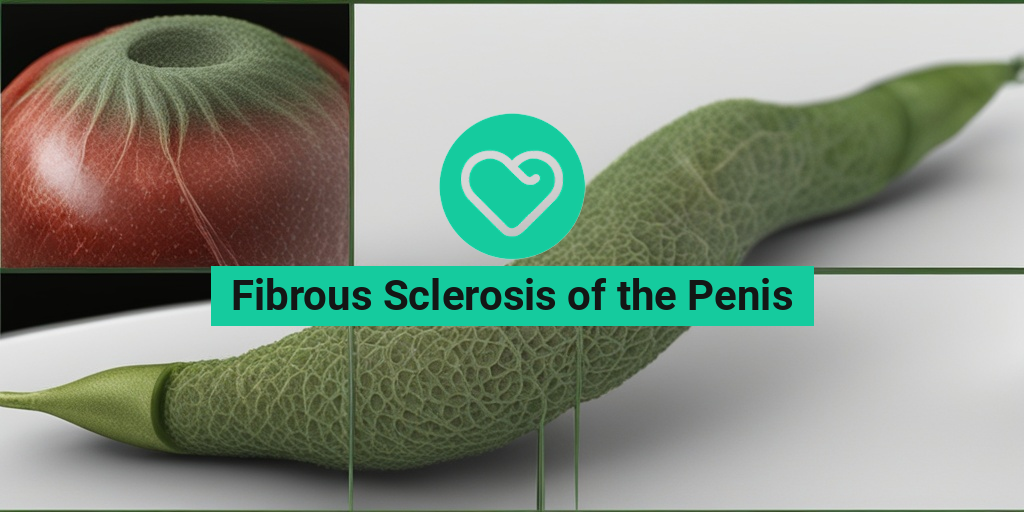What Is Fibrous Sclerosis of the Penis?
Fibrous sclerosis of the penis, also known as Peyronie’s disease, is a condition that affects the penis, causing it to curve or bend abnormally during an erection. This curvature can be painful and make sexual intercourse difficult or even impossible. But what exactly is fibrous sclerosis, and how does it affect the penis?
The Causes of Fibrous Sclerosis
The exact cause of fibrous sclerosis is still unknown, but research suggests that it may be related to genetics, injury, or inflammation. Some studies suggest that men who have a family history of Peyronie’s disease are more likely to develop the condition. Additionally, men who have experienced trauma to the penis, such as a sports injury or a car accident, may be more prone to developing fibrous sclerosis.
The Symptoms of Fibrous Sclerosis
The symptoms of fibrous sclerosis can vary from person to person, but common signs include:
- A noticeable curvature of the penis during an erection
- Pain during an erection or sexual intercourse
- Difficulty achieving or maintaining an erection
- A lump or hard area on the penis
- Shortening of the penis
If you’re experiencing any of these symptoms, it’s essential to consult with a healthcare professional for an accurate diagnosis and treatment plan.
Understanding Peyronie’s Disease
Peyronie’s disease is a condition that affects the penis, causing it to curve or bend abnormally during an erection. But what exactly happens during Peyronie’s disease, and how does it relate to fibrous sclerosis?
The Role of Scar Tissue
In Peyronie’s disease, scar tissue forms in the penis, causing it to curve or bend. This scar tissue, also known as plaque, can be made up of collagen and elastin, which are essential proteins for healthy skin and connective tissue. However, in Peyronie’s disease, the scar tissue becomes inflamed, leading to the formation of a hard, fibrous area on the penis.
The Connection to Fibrous Sclerosis
Fibrous sclerosis is a type of Peyronie’s disease, characterized by the formation of scar tissue in the penis. The scar tissue causes the penis to curve or bend, leading to painful erections and difficulty with sexual intercourse. In some cases, fibrous sclerosis can lead to erectile dysfunction, making it essential to seek medical attention if you’re experiencing any symptoms.
If you’re struggling with fibrous sclerosis or Peyronie’s disease, it’s essential to consult with a healthcare professional for an accurate diagnosis and treatment plan. Additionally, resources like Yesil Health AI can provide evidence-based health answers and support to help you navigate your condition. 🏥
Remember, fibrous sclerosis and Peyronie’s disease are treatable conditions, and with the right support and treatment, you can regain control over your sexual health. 💪

Fibrous Sclerosis of the Penis Symptoms
Fibrous sclerosis of the penis, also known as Peyronie’s disease, is a condition characterized by the formation of scar tissue in the penis, leading to painful erections, curvature, and other symptoms. If you’re experiencing any unusual changes in your penis, it’s essential to recognize the symptoms of fibrous sclerosis to seek timely medical attention.
Common Symptoms of Fibrous Sclerosis
The symptoms of fibrous sclerosis can vary from person to person, but common signs include:
- Painful erections: Pain during erection is one of the most common symptoms of fibrous sclerosis. The pain can be mild or severe and may occur during sexual activity or even when the penis is flaccid.
- Curvature of the penis: The formation of scar tissue can cause the penis to curve or bend, making sexual intercourse difficult or painful.
- Lumps or nodules: You may feel lumps or nodules under the skin of the penis, which can be tender to the touch.
- Erectile dysfunction: Fibrous sclerosis can lead to erectile dysfunction, making it difficult to achieve or maintain an erection.
- Shortening of the penis: In some cases, the scar tissue can cause the penis to shorten, leading to a decrease in penile length.
- Loss of sexual function: Fibrous sclerosis can lead to a loss of sexual function, making it difficult to engage in sexual activities.
Other Possible Symptoms
In addition to the common symptoms mentioned above, some men may experience:
- Painful orgasm: Pain during orgasm can be a symptom of fibrous sclerosis.
- Penile narrowing: The scar tissue can cause the penis to narrow, making sexual intercourse difficult.
- Penile instability: The penis may feel unstable or wobbly during erection.
If you’re experiencing any of these symptoms, it’s essential to consult a healthcare professional for proper diagnosis and treatment. Early intervention can help alleviate symptoms and improve sexual function.
Causes and Risk Factors of Fibrous Sclerosis
While the exact cause of fibrous sclerosis is unknown, several factors can contribute to its development. Understanding the causes and risk factors can help you take preventive measures and seek timely medical attention if you experience any symptoms.
Genetic Predisposition
Research suggests that fibrous sclerosis may have a genetic component, as it tends to run in families. If you have a family history of Peyronie’s disease, you may be more likely to develop fibrous sclerosis.
Trauma to the Penis
Trauma to the penis, such as a penile fracture or injury, can lead to the formation of scar tissue, increasing the risk of fibrous sclerosis.
Age
Fibrous sclerosis is more common in men over 40, with the risk increasing with age.
Other Medical Conditions
Certain medical conditions, such as diabetes, high blood pressure, and atherosclerosis, can increase the risk of fibrous sclerosis.
Lifestyle Factors
Lifestyle factors, such as smoking and alcohol consumption, can also contribute to the development of fibrous sclerosis.
While these factors can increase the risk of fibrous sclerosis, it’s essential to remember that the condition can affect anyone, regardless of age or health status. If you’re experiencing any symptoms, don’t hesitate to consult a healthcare professional for proper diagnosis and treatment. 💊

How Is Fibrous Sclerosis of the Penis Diagnosed?
Fibrous sclerosis of the penis, also known as Peyronie’s disease, is a condition characterized by the formation of scar tissue in the penis, leading to curvature, pain, and erectile dysfunction. Diagnosing this condition can be a bit challenging, but a combination of physical examination, medical history, and diagnostic tests can help identify the problem.
Physical Examination
A doctor will typically start by performing a physical examination of the penis to look for any visible signs of Peyronie’s disease. This may include:
- Palpating the penis to feel for any lumps or areas of scarring
- Checking for any curvature or deformity of the penis
- Assessing the penis for any areas of tenderness or pain
Medical History
The doctor will also take a thorough medical history to identify any underlying conditions that may be contributing to the development of Peyronie’s disease. This may include:
- Any previous injuries to the penis or groin area
- A history of erectile dysfunction or other sexual health issues
- Any underlying medical conditions, such as diabetes or high blood pressure
Diagnostic Tests
In some cases, diagnostic tests may be necessary to confirm the diagnosis of Peyronie’s disease. These may include:
- Ultrasound: This test uses high-frequency sound waves to create images of the penis and surrounding tissues.
- X-ray: This test uses X-rays to create images of the penis and surrounding bones.
- Duplex ultrasound: This test uses a combination of ultrasound and Doppler technology to measure blood flow to the penis.
These tests can help identify any areas of scarring or plaque buildup in the penis, which can confirm the diagnosis of Peyronie’s disease.
Treatment Options for Fibrous Sclerosis of the Penis
Treatment for fibrous sclerosis of the penis, or Peyronie’s disease, typically focuses on reducing symptoms and improving sexual function. The goal of treatment is to:
- Reduce pain and discomfort during sex
- Improve erectile function
- Correct curvature or deformity of the penis
Conservative Treatment Options
In some cases, conservative treatment options may be recommended to manage symptoms and improve sexual function. These may include:
- Medications: Such as pentoxifylline, which can help reduce inflammation and improve blood flow to the penis.
- Penile traction therapy: This involves using a device to gently stretch the penis and improve curvature.
- Lifestyle changes: Such as quitting smoking, exercising regularly, and managing stress.
Surgical Treatment Options
In more severe cases, surgical treatment may be necessary to correct curvature or deformity of the penis. These may include:
- Nesbit procedure: This involves removing or rearranging scar tissue to improve curvature.
- Penile implant: This involves implanting a device to help improve erectile function.
- Grafting: This involves using a graft to cover areas of scarring or plaque buildup.
It’s essential to work closely with a healthcare provider to determine the best course of treatment for fibrous sclerosis of the penis. With the right treatment, it’s possible to manage symptoms and improve sexual function. 💊

Medications for Fibrous Sclerosis of the Penis
Fibrous sclerosis of the penis, also known as Peyronie’s disease, is a condition characterized by the formation of scar tissue in the penis, leading to curvature, pain, and erectile dysfunction. While there is no cure for Peyronie’s disease, medications can help alleviate symptoms and improve quality of life. In this section, we’ll explore the various medications used to treat fibrous sclerosis of the penis.
Oral Medications
Oral medications are often the first line of treatment for Peyronie’s disease. These medications aim to reduce inflammation, improve blood flow, and break down scar tissue. Some common oral medications used to treat fibrous sclerosis of the penis include:
- Pentoxifylline: This medication improves blood flow and reduces inflammation, which can help reduce curvature and improve erectile function.
- Vitamin E: Vitamin E is an antioxidant that helps reduce oxidative stress and inflammation, which can contribute to scar tissue formation.
- Colchicine: This medication reduces inflammation and improves collagen production, which can help break down scar tissue.
- Tadalafil (Cialis): This medication is commonly used to treat erectile dysfunction and can also help improve blood flow to the penis, reducing curvature.
Intralesional Injections
Intralesional injections involve injecting medication directly into the scar tissue in the penis. This approach can be more effective than oral medications for some men. Common intralesional injections used to treat fibrous sclerosis of the penis include:
- Verapamil: This medication helps reduce calcium levels in the scar tissue, which can help break it down and improve curvature.
- Interferon: This medication stimulates the immune system to break down scar tissue and promote collagen production.
- Xiaflex: This medication contains collagenase, an enzyme that breaks down collagen in scar tissue, helping to improve curvature and reduce pain.
It’s essential to note that medications may not work for everyone, and it may take some trial and error to find the right combination of medications that work for you. Additionally, medications may have side effects, so it’s crucial to discuss the risks and benefits with your healthcare provider. 💊
Surgery for Fibrous Sclerosis of the Penis
In some cases, surgery may be necessary to treat fibrous sclerosis of the penis, especially if medications are ineffective or if the curvature is severe. Surgery can help straighten the penis, improve erectile function, and reduce pain. There are several surgical options available, including:
Nesbit Procedure
The Nesbit procedure involves removing or rearranging the scar tissue in the penis to straighten it. This procedure is usually recommended for men with mild to moderate curvature.
Plication Procedure
The plication procedure involves folding or gathering the scar tissue in the penis to reduce curvature. This procedure is often used for men with more severe curvature.
Penile Implants
In some cases, penile implants may be necessary to treat erectile dysfunction associated with fibrous sclerosis of the penis. Penile implants can help improve erectile function and reduce curvature.
Surgery carries risks, such as infection, scarring, and erectile dysfunction. It’s essential to discuss the risks and benefits with your healthcare provider and consider all options carefully before making a decision. 💔
Remember, it’s crucial to work closely with your healthcare provider to determine the best course of treatment for your fibrous sclerosis of the penis. With the right treatment, you can improve your symptoms and regain confidence in your sexual health. 💪

Fibrous Sclerosis of the Penis: Frequently Asked Questions
Fibrous sclerosis of the penis, also known as Peyronie’s disease, is a condition characterized by the formation of scar tissue in the penis, leading to curvature, pain, and erectile dysfunction. Here are some frequently asked questions about fibrous sclerosis of the penis:
What are the symptoms of fibrous sclerosis of the penis?
The symptoms of fibrous sclerosis of the penis may vary from person to person, but common symptoms include:
- Painful erections
- Curvature of the penis
- Erectile dysfunction
- Shortening of the penis
- Lumps or hard areas on the penis
What causes fibrous sclerosis of the penis?
The exact cause of fibrous sclerosis of the penis is not fully understood, but it is believed to be related to:
- Genetic predisposition
- Trauma to the penis
- Vascular disease
- Autoimmune disorders
How is fibrous sclerosis of the penis diagnosed?
Fibrous sclerosis of the penis is typically diagnosed through a combination of:
- Physical examination
- Medical history
- Imaging tests, such as ultrasound or MRI
What are the treatment options for fibrous sclerosis of the penis?
Treatment options for fibrous sclerosis of the penis may include:
- Medications to reduce pain and inflammation
- Penile traction therapy
- Surgery, such as penile implant or plaque excision
- Shockwave therapy
Can fibrous sclerosis of the penis be prevented?
While there is no sure way to prevent fibrous sclerosis of the penis, maintaining a healthy lifestyle, avoiding trauma to the penis, and managing underlying medical conditions may help reduce the risk of developing the condition.
Is fibrous sclerosis of the penis a sign of other underlying health issues?
Fibrous sclerosis of the penis may be associated with other underlying health issues, such as:
- Vascular disease
- Diabetes
- Hypertension
- High cholesterol
Can fibrous sclerosis of the penis affect sexual relationships?
Fibrous sclerosis of the penis can affect sexual relationships, causing emotional distress and intimacy issues. It’s essential to communicate openly with your partner and seek support from a healthcare professional or sex therapist if needed.
Is fibrous sclerosis of the penis a rare condition?
Fibrous sclerosis of the penis is a relatively rare condition, affecting approximately 1 in 200 men. However, it’s essential to seek medical attention if you’re experiencing symptoms to receive proper diagnosis and treatment.
Remember, if you’re experiencing symptoms of fibrous sclerosis of the penis, don’t hesitate to consult with a healthcare professional for proper diagnosis and treatment. 💊




